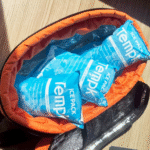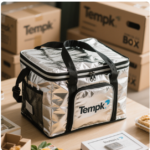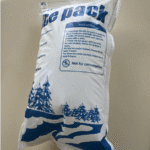Shipping perishables requires precise temperature control. Dry ice for cooler dry ice packs offers a superior cooling solution, maintaining subzero temperatures without melting into water. This guide will walk you through the essentials of using dry ice, ensuring your goods remain cold, frais, and safe during transportation.

What Are Dry Ice Packs for Coolers?
Dry ice packs are solid blocks of carbon dioxide (Co₂) that provide consistent cooling in shipping containers or coolers. Contrairement à la glace ordinaire, dry ice sublimates directly into CO₂ gas, ne laissant aucun liquide derrière. At a temperature of -78.5°C (-109.3°F), dry ice maintains a far colder temperature than ice or gel packs, making it perfect for sensitive items such as vaccines, fruit de mer, et les biologiques.
How Does Dry Ice Work in Coolers?
Dry ice works by releasing cold energy through sublimation. Contrairement à la glace traditionnelle, qui fond dans l'eau, dry ice avoids water damage and maintains a much lower temperature for a longer period. Quand la glace sèche sublime, it directly transforms into gas, ensuring that the contents of the cooler remain frozen. This property makes dry ice ideal for long-distance shipping and storing perishable goods, as it provides consistent cold without the mess of melting ice.
Benefits of Using Dry Ice for Cooler Packs:
-
Durée de refroidissement plus longue: La glace sèche dure plus longtemps que la glace traditionnelle, keeping items colder for extended periods, which is ideal for long trips.
-
Pas de résidu d'eau: Depuis la glace sèche sublime dans le gaz, there is no risk of water damaging goods or packaging.
-
Efficient Use of Space: Dry ice takes up less space compared to traditional ice, leaving more room for your products.
-
Better for Sensitive Items: Dry ice is essential for goods requiring precise, ultra-low temperatures like vaccines, échantillons de biotechnologie, or specialty food items such as seafood.
Guide étape par étape: How to Use Dry Ice for Cooler Packs
Using dry ice in a cooler is a straightforward process, but it requires specific handling to ensure safety and effectiveness. Here’s how to properly pack and handle dry ice in coolers.
Étape 1: Choisissez le bon refroidisseur
When selecting a cooler, the most important factors to consider are insulation and ventilation. Une glacière de haute qualité, like those from YETI or Grizzly, helps retain cold air, minimizing sublimation and extending the lifespan of dry ice.
-
Isolation: Thick insulation reduces the rate at which dry ice sublimates. A well-insulated cooler ensures your dry ice will last longer and maintain a consistent temperature.
-
Ventilation: La glace sèche sublimait le dioxyde de carbone, which can build up pressure inside the cooler. Ensure that your cooler has proper ventilation holes to allow gas to escape safely.
Étape 2: Manipulez la glace sèche en toute sécurité
Dry ice is extremely cold and requires careful handling to avoid injury. Always wear insulated gloves or use tongs when handling dry ice to prevent frostbite. Pour les envois plus importants, ensure that dry ice is packed securely to avoid any movement that might damage your goods during transit.
Étape 3: Pack the Goods and Dry Ice
Once you’ve prepared your cooler, it’s time to pack the dry ice and goods together. Here’s how to layer your cooler for maximum efficiency:
-
Couche inférieure: Place the dry ice at the bottom of the cooler, as cold air naturally sinks.
-
Barrier Layer: Add a layer of newspaper or cardboard above the dry ice to prevent direct contact with the goods. This will help protect sensitive items from the extreme cold.
-
Top Layer: Place your frozen or perishable items above the barrier. Make sure items are tightly packed to minimize air space and prevent temperature fluctuations.
Étape 4: Seal the Cooler
Once the cooler is packed, securely close the lid. Cependant, don’t seal it airtight. Carbon dioxide gas needs a way to escape to avoid pressure buildup that could cause the cooler to burst. If your cooler has a drain plug, leave it slightly open for ventilation.
Étape 5: Surveiller la température
For sensitive shipments, it’s a good practice to monitor the internal temperature during transit. Appareils de surveillance de la température, such as data loggers or wireless sensors, can provide real-time updates and ensure the temperature stays within the desired range.
Étape 6: Dispose of Dry Ice Safely
Once the dry ice has sublimated, dispose of it safely in a well-ventilated area. Never dispose of dry ice in a sealed container, as the buildup of gas can lead to an explosion.
Best Practices for Using Dry Ice for Coolers
To make the most of dry ice for your shipments, Considérez les meilleures pratiques suivantes:
-
Plan for Sublimation: La glace carbonique se sublime à une vitesse d'environ 5-10 des livres chacun 24 heures. Always calculate how much dry ice you need based on this rate to ensure that it lasts for the required duration.
-
Monitor Temperature Sensitivity: For highly sensitive items, like pharmaceuticals, il est essentiel de maintenir la bonne température. Use temperature sensors or data loggers to ensure that conditions stay within the specified range.
-
Plan for Ventilation: Always ensure that the cooler allows proper gas release. If you’re shipping a large quantity of dry ice, consider using containers specifically designed to handle carbon dioxide.
Glace sèche vs. Gel Packs vs. Glace ordinaire: Qui est le meilleur?
| Fonctionnalité | Glace sèche | Packs de gel | Glace ordinaire |
|---|---|---|---|
| Température | -109.3°F (-78.5°C) | Varie, typically 32°F-0°F | 32°F (0°C) |
| Durée de refroidissement | 12–24 hours or more | 1–3 days depending on type | 1–10 days depending on cooler |
| Résidu | Sublimer le gaz, pas de liquide | Leaves gel residue | Fond dans l'eau |
| Utilisation idéale | Frozen items, vaccins, fruit de mer | Refroidissement à court terme | Boissons, parcours courts |
Dry ice is ideal for situations that require subzero temperatures and extended cooling, such as transporting frozen meats, fruit de mer, ou pharmaceutiques. En revanche, gel packs are better for moderate cooling needs, like shipping beverages or perishable items that don’t need freezing temperatures.
Questions fréquemment posées (FAQ)
Q1: How much dry ice do I need for a 25-quart cooler?
A standard guideline is to use 10 à 15 pounds of dry ice per day. For a 25-quart cooler, this should suffice for a 1–2 day trip.
Q2: Puis-je utiliser de la neige carbonique pour l'expédition de produits alimentaires?
Oui, dry ice is commonly used for shipping perishable foods, especially those that require sub-zero temperatures, such as seafood or frozen items.
Q3: Combien de temps dure la glace sèche dans une glacière?
Dry ice typically lasts 12–24 hours in an insulated cooler, depending on the amount used and the external temperature.
Q4: Can I dispose of dry ice in a trash can?
Non, dry ice must be allowed to sublimate in a well-ventilated area. Never dispose of it in a sealed container or trash can as this can cause an explosion.
Conclusion
Dry ice for cooler dry ice packs is an effective and reliable solution for shipping temperature-sensitive items. En comprenant le fonctionnement de la neige carbonique, how to handle it safely, and how to pack it efficiently, you can ensure your goods remain fresh and safe during transit. Que vous expédiiez de la nourriture, médicaments, or biotech samples, dry ice provides an unbeatable solution for cold chain logistics.
Pour des résultats optimaux, plan ahead, calculate your dry ice requirements, and use appropriate containers and safety measures.























